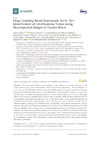Identificador persistente para citar o vincular este elemento:
https://accedacris.ulpgc.es/jspui/handle/10553/58284
| Título: | Deep learning-based framework for In Vivo identification of glioblastoma tumor using hyperspectral images of human brain | Autores/as: | Fabelo Gómez, Himar Antonio Halicek, Martin Ortega Sarmiento, Samuel Shahedi, Maysam Zbigniew Szolna,Adam Piñeiro, Juan F. Sosa Pérez, Coralia J-O’Shanahan, Aruma Bisshopp, Sara Espino, Carlos Márquez, Mariano Hernández, María Carrera, David Morera Molina, Jesús Manuel Marrero Callicó, Gustavo Iván Sarmiento Rodríguez, Roberto Fei, Baowei |
Clasificación UNESCO: | 3314 Tecnología médica | Palabras clave: | Brain tumor Cancer surgery Hyperspectral imaging Bioinformatics Intraoperative imaging, et al. |
Fecha de publicación: | 2019 | Proyectos: | Identificación Hiperespectral de Tumores Cerebrales (Ithaca) Plataforma H2/Sw Distribuida Para El Procesamiento Inteligente de Información Sensorial Heterogenea en Aplicaciones de Supervisión de Grandes Espacios Naturales Hyperspectral Imaging Cancer Detection (Helicoid) (Contrato Nº 618080) |
Publicación seriada: | Sensors | Resumen: | The main goal of brain cancer surgery is to perform an accurate resection of the tumor, preserving as much normal brain tissue as possible for the patient. The development of a non-contact and label-free method to provide reliable support for tumor resection in real-time during neurosurgical procedures is a current clinical need. Hyperspectral imaging is a non-contact, non-ionizing, and label-free imaging modality that can assist surgeons during this challenging task without using any contrast agent. In this work, we present a deep learning-based framework for processing hyperspectral images of in vivo human brain tissue. The proposed framework was evaluated by our human image database, which includes 26 in vivo hyperspectral cubes from 16 different patients, among which 258,810 pixels were labeled. The proposed framework is able to generate a thematic map where the parenchymal area of the brain is delineated and the location of the tumor is identified, providing guidance to the operating surgeon for a successful and precise tumor resection. The deep learning pipeline achieves an overall accuracy of 80% for multiclass classification, improving the results obtained with traditional support vector machine (SVM)-based approaches. In addition, an aid visualization system is presented, where the final thematic map can be adjusted by the operating surgeon to find the optimal classification threshold for the current situation during the surgical procedure. | URI: | https://accedacris.ulpgc.es/handle/10553/58284 | ISSN: | 1424-8220 | DOI: | 10.3390/s19040920 | Fuente: | Sensors [ISSN 1424-8220], v. 19 (4), artículo 920 |
| Colección: | Artículos |
Citas SCOPUSTM
146
actualizado el 08-jun-2025
Citas de WEB OF SCIENCETM
Citations
108
actualizado el 08-jun-2025
Visitas
76
actualizado el 10-ene-2026
Descargas
105
actualizado el 10-ene-2026
Google ScholarTM
Verifica
Altmetric
Comparte
Exporta metadatos
Los elementos en ULPGC accedaCRIS están protegidos por derechos de autor con todos los derechos reservados, a menos que se indique lo contrario.
